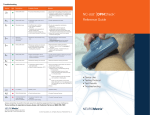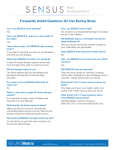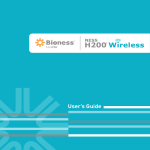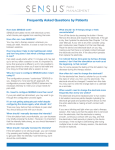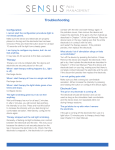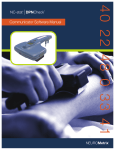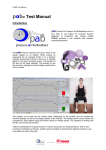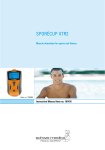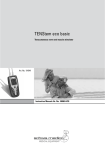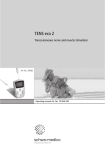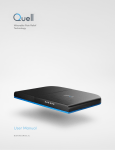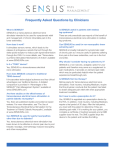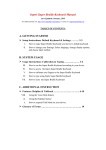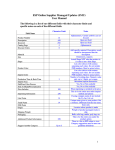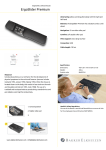Download Combined Median-Ulnar Electrode Placement Guide
Transcript
Median-Ulnar Nerve-Specific Electrode Set Median-Ulnar Combined Electrode Placement Instructions (NC-S93, NC-S94) Right Left Select Left or Right Electrode The Median-Ulnar Motor-Sensory Electrodes are Left and Right specific. Choose the correct one for the hand to be tested. One size fits all. Position patient Have the patient position his or her arm so that it is extended and resting comfortably on a firm surface with the palm up and thumb extended out. Right Left Prepare skin Using the alcohol pumice prep pad provided with the electrode, vigorously scrub the front, back, and sides of the wrist, the entire thenar palm area, the thumb and the ring finger. The prep pad is designed to cleanse and mildly abrade the skin. Skin prep, as described above, is required for proper Electrode contact with the skin and enhances the performance of the Electrode. Allow Skin to Air Dry (approximately 30 seconds) Using the back of your hand, check the patient’s skin to ensure that it is completely dry. For Customer Service call 1.888.786.7287 62 Fourth Avenue, Waltham, MA 02451 www.neurometrix.com (Continued on next page) Right Left Distal Wrist Crease Distal Wrist Crease Determine Electrode Placement It is critical to determine Electrode placement before removing the backing. The adhesive side of the Electrode should contact the skin only once and should not be repositioned once affixed. 1. Locate the distal wrist crease by having the patient flex their wrist. Mark Palmaris Longus tendon at Distal Wrist Crease Mark Palmaris Longus tendon at Distal Wrist Crease 2. Identify the Palmaris Longus tendon by having the patient place their thumb and pinky finger together while flexing the hand at the wrist. 3. Use a skin marker to mark the location of the tendon at the wrist crease. 4. Locate and mark the Flexor Carpi Ulnaris tendon at the patient’s distal wrist crease by aligning the notch on the wrist portion of Part B with the middle of the 5th digit (pinky). Make sure the fingers are extended straight and positioned together. 5. With the backing still on the Electrode, take Part A of the Electrode and place the tip of the notch marked “wrist crease” on the Palmaris Longus tendon mark, aligning the patient’s wrist crease with the dotted line. Both top and bottom notches of Part A should point toward the center of the middle finger when the fingers are extended straight. 6. Ensure that the thumb is fully extended and fingers are together before continuing. The notch of the thenar part of the Electrode should point toward the base of the thumb. 7. Mark the location of the two remaining notches on the forearm and palm. 8. Locate and mark the distal joint on the thumb. 9. Slide the Electrode over so that the wrist notch of Part B aligns with the Flexor Carpi Ulnaris tendon mark. Position Part B so that both notches align with the center of the 5th digit (pinky). Mark the forearm notch location. Right Left Affix Part A – Median Wrist and Palm 1. Remove the backing from Part A only of the Electrode. 2. Locate the marks on the wrist, forearm and palm. 3. Holding Part A by the tabs, align the notches with the marks on the wrist, forearm, and palm. Smooth Part A of the Electrode firmly against the patient’s wrist and palm, starting at the center and working outward. 4. Make sure the entire Electrode is adhered to the skin. Smooth and consistent skin contact is critical. Right Left Affix Part B – Ulnar Wrist 1. Remove the backing from Part B of the Electrode. 2. Locate the marks on the wrist and forearm. 3. Holding Part B by the tab, align the notches with the marks on the wrist and forearm.* Right Left 4. Smooth Part B of the Electrode firmly against the patient’s wrist starting at the middle and working outward. Affix Part C – Thumb 1. Remove the backing from Part C of the Electrode. Ensure that the patient’s thumb is fully extended and straight. Holding Part C of the Electrode by the tab, place the tip of the arrow on the mark that was made on the distal thumb joint. Wrap Part C snugly around thumb. (Continued on back page) *Please note that for small wrists, correct positioning of the ulnar wrist portion may mean that the edge of Part B touches the edge of Part A. Parts A and B should not overlap. Adjust Part B if necessary. The connectors between Part A and B are flexible; fold to accommodate Part B correctly on skin. Right Left Affix Part D – Ring Finger 1. Stretch taut the sensory portion of the tail over the patient’s ring finger. 2. Determine which of the four numbers on the tail is closest to the patient’s proximal joint, and place a mark at that number. Remember this number, you will be prompted to enter this number on the device prior to initiating the test. If two numbers are both close to the proximal joint, choose the smaller number. 3. Remove backing from Part D of the Electrode. Ensure that the patient’s ring finger is straight. 4. Hold Part D of the Electrode by the tabs. Place the tip of the arrow on the mark that was made on the ring finger. 5. Wrap Part E snugly around the ring finger, making sure that the Electrode is wrapped on top of itself. 6. Wrap Part F in the same manner. Connect Electrode to the ADVANCE Device CAUTION: The combined Median-Ulnar Electrode MUST be connected to the ADVANCE Combined NSE Adapter. This Electrode will not operate without this adapter. Wait 30 seconds Wait at least 30 seconds prior to testing while the Electrode stabilizes on the skin. Relax patient Ensure that the patient remains relaxed, still and quiet during the test. ATTENTION: Refer to the Device User Manual prior to utilizing the Device. For Customer Service call 1.888.786.7287 62 Fourth Avenue, Waltham, MA 02451 www.neurometrix.com ©2011 NeuroMetrix, Inc. All rights reserved. The use of any devices or administration of any therapies discussed or referred to in this publication should always be consistent with indications and prescribing information approved by the FDA. US Patent No. 5,851,191; 5,976,094; 6,132,386; 6,132,387; 6,146,335; 6,266,558; 6,379,313; 6,507,755; 6,692,444. PN 2203375 Rev. B




